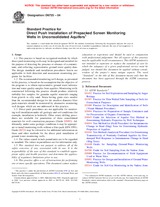Potřebujeme váš souhlas k využití jednotlivých dat, aby se vám mimo jiné mohly ukazovat informace týkající se vašich zájmů. Souhlas udělíte kliknutím na tlačítko „OK“.
ASTM D6725-04
Standard Practice for Direct Push Installation of Prepacked Screen Monitoring Wells in Unconsolidated Aquifers
Automaticky přeložený název:
Standardní praxe pro Direct Push instalaci balených monitorovacího Screen Wells v nekonsolidované zvodních
NORMA vydána dne 1.7.2004
Informace o normě:
Označení normy: ASTM D6725-04
Poznámka: NEPLATNÁ
Datum vydání normy: 1.7.2004
Kód zboží: NS-36287
Počet stran: 15
Přibližná hmotnost: 45 g (0.10 liber)
Země: Americká technická norma
Kategorie: Technické normy ASTM
Anotace textu normy ASTM D6725-04 :
Keywords:
aquifer, direct push, ground water, monitoring well, prepacked screen, water quality, ICS Number Code 13.060.10 (Water of natural resources)
Doplňující informace
| Significance and Use | ||||||||||||||||||||||||||||||||||||||||||||||||||||||||||
|
This practice is intended to provide the user with information on the appropriate methods and procedures for installing prepacked screen monitoring wells by direct push methods. The monitoring wells may be used to obtain representative water quality samples for aqueous phase contaminants or other analytes of interest, either organic or inorganic (Kram et al. 2000, McCall 2000, McCall et al. 1997). The monitoring wells may also be used to obtain information on the potentiometric surface of the local aquifer and properties of the formation such as hydraulic conductivity or transmissivity. Use of direct push methods to install monitoring wells can significantly reduce the amount of potentially hazardous drill cuttings generated during well installation at contaminated sites. This may significantly reduce cost of an environmental site investigation and ground water monitoring program. Minimizing generation of hazardous waste also reduces the exposure hazards to site workers, local residents, and the environment. Direct push methods for monitoring well installation are limited to use in unconsolidated formations such as alluvial/stream sediments, glacial deposits, and beach type sediments. Direct push methods are generally successful at penetrating clays, silts, sands and some gravel. Deposits such as soils with thick caliche layers, or glacial tills with large cobbles or boulders may be difficult or impossible to penetrate to the desired depth. Direct push methods are not designed for penetration of consolidated bedrock such as limestone, granite or gneiss. |
||||||||||||||||||||||||||||||||||||||||||||||||||||||||||
| 1. Scope | ||||||||||||||||||||||||||||||||||||||||||||||||||||||||||
|
1.1 This practice is based on recognized methods by which direct push monitoring wells may be designed and installed for the purpose of detecting the presence or absence of a contaminant, and collecting representative ground water quality data. The design standards and installation procedures herein are applicable to both detection and assessment monitoring programs for facilities. 1.2 The recommended monitoring well design, as presented in this practice, is based on the assumption that the objective of the program is to obtain representative ground water information and water quality samples from aquifers. Monitoring wells constructed following this practice should produce relatively turbidity-free samples for granular aquifer materials ranging from gravels to silty sand. Strata having grain sizes smaller than the recommended design for the smallest diameter filter pack materials should be monitored by alternative monitoring well designs which are not addressed in this practice. 1.3 Direct push procedures are not applicable for monitoring well installation under all geologic and soil conditions (for example, installation in bedrock). Other rotary drilling procedures are available for penetration of these consolidated materials for well construction purposes (Guide D 5092). Additionally, under some geologic conditions it may be appropriate to install monitoring wells without a filter pack (EPA 1991). Guide D 6724 may be referred to for additional information on these and other methods for the direct push installation of ground water monitoring wells. 1.4 The values stated in inch-pound units are to be regarded as standard. The values in parentheses are for information only. This standard does not purport to address all of the safety concerns, if any, associated with its use. It is the responsibility of the user of this standard to establish appropriate safety and health practices and determine the applicability of regulatory limitations prior to use. This practice offers a set of instructions for performing one or more specific operations. This document cannot replace education or experience and should be used in conjunction with professional judgement. Not all aspects of this practice may be applicable in all circumstances. This ASTM standard is not intended to represent or replace the standard of care by which the adequacy of a given professional service must be judged, nor should this document be applied without consideration of the project's many unique aspects. The word "Standard" in the title of this document means only that the document has been approved through the ASTM consensus process. |
||||||||||||||||||||||||||||||||||||||||||||||||||||||||||
| 2. Referenced Documents | ||||||||||||||||||||||||||||||||||||||||||||||||||||||||||
|
Odebírejte informace o nově vydaných normách ZDARMA:
Chcete pravidelně odebírat informace o nově vycházejících normách z celého světa a to zcela zdarma?
Přihlašte se k odběru. Vše je velice jednoduché a absolutně ZDARMA.
Na výběr máte vydavatele z celého světa.




 Cookies
Cookies
